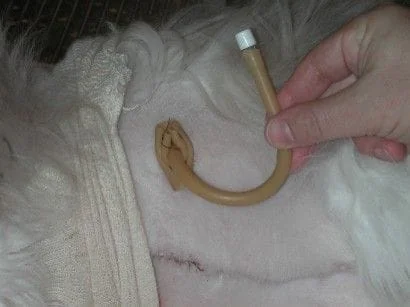Key Points
A PEG tube is a stomach tube that is placed into the stomach, through the body wall on the left side of the pet, usually with the assistance of a flexible camera called an endoscope
This is an excellent means to provide a route for feeding if your pet will not eat
PEG tube
- A PEG tube is a stomach tube that is placed into the stomach, through the body wall on the left side of the pet, usually with the assistance of a flexible camera called an endoscope
- The procedure
- the pet is anesthetized
- the left side of the abdomen is shaved
- an endoscope is placed into the stomach via the mouth
- a strong suture is placed through the outer body wall into the stomach which is distended with gas
- the suture is retrieved with the scope and pulled from the stomach to the mouth
- the stomach tube is tied to the suture and pulled into the stomach and out of the body wall
- the stomach tube is secured in place
- a cap is placed on the end of the stomach tube
Indications for a PEG tube
- Any animal that refuses to eat or take in adequate amounts of food and water
- Many diseases can cause lack of appetite
- Injury or fracture of the jaw bones
- In cats, fatty liver disease is an indication to have the tube placed
- Below is a cat that has a PEG tube in place; a shirt is used to cover the tube


Care of PEG tube
- For the first 2 weeks the skin around the PEG tube should be gently cleansed to remove any discharge using a clean Q-tip and hydrogen peroxide or dilute antiseptic solution such as Betadine or Chlorhexidine; thereafter, occasional cleaning may be needed

- After the site has been cleansed, triple antibiotic ointment such as Neosporin is applied to help heal the site

Feeding through the PEG tube
- Prior to feeding, the amount of stomach contents is measured by aspirating on the stomach tube with a 35 or 60 ml catheter tip syringe
- If the residual fluid in the stomach is greater than 15 ml, the feeding is delayed for a couple of hours and the residuals are rechecked again
- Generally the residual fluids are removed and discarded; it is unusual that discarding the fluid will cause alkalosis or significant electrolyte problems in the blood
- A total needed amount of feeding will be calculated for your pet; this amount is divided into about 4 equal feedings per day
- We usually recommend a dense food such as Iams Maximum-Calorie Plus diet as smaller volumes of food are needed versus other brands; after a can of food is opened it should be refrigerated; it should be warmed to a luke warm temperature prior to feeding; usually a small amount of water is added to the food to make it more liquid and easier to pass through the PEG tube
- Always flush the PEG tube with 15 ml of luke warm water after administering food or medications through the PEG tube
- Place the cap back on the tube after feeding or administration of medications via the tube
- If your pet is not drinking, additional water is recommended
- Daily requirement of water is roughly 60 ml/kg/24hours
- calculate the amount of water that is in the food (about 70% of total food fed per day) and subtract this from the daily requirement
- Subtract also the 15 ml of water that is used to flush the tube after each feeding
- Always offer food free choice of food – once the pet is eating well the PEG feedings can be stopped or gradually weaned off
Improving passage of food through the stomach
- If you find that the residual amount of fluid/food in the stomach is greater than 15 ml prior to a feeding, your pet likely has poor motility of the stomach, thus the food and fluids are not being properly pumped out of the stomach
- Encouraging your pet to walk around after the feeding will help to get the stomach to pump the food into the intestine
- Medications are sometimes prescribed to help empty the stomach
Unclogging a PEG tube
- If food has not been adequately flushed through the PEG tube after a feeding, the tube may become clogged
- Try flushing the tube with luke warm water
- If this is not effective, put 5 ml Coca cola down the tube and let it sit for about 30 minutes, then flush with luke warm water
- If this is not effective consult us or your regular veterinarian
Removal of a PEG tube
- A PEG tube must stay in place for about 10 days prior to removal so that peritonitis or infection of the abdominal cavity does not occur
- The PEG tube should be removed by a veterinarian; the tube is simply pulled out and does not require anesthesia
- The tube is generally removed once the pet is eating well
Potential complications
- Anesthetic death – rare
- Infection – uncommon
- Poor stomach motility
- Vomiting from feeding too fast or too much food at one time
- Premature dislodgement of the stomach tube


